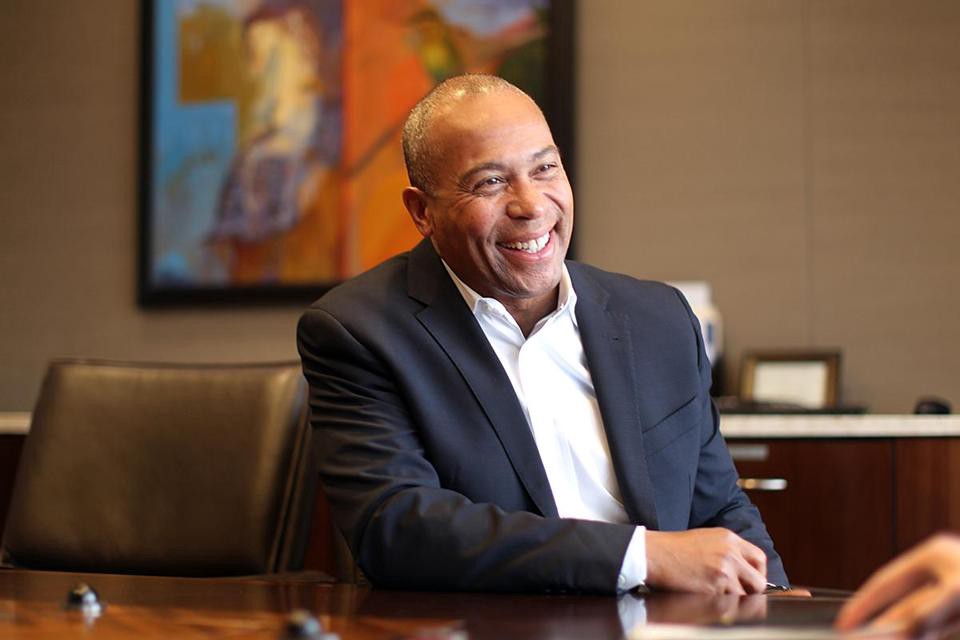The tipoff that impact investing is indeed reaching a new stage in the capital markets came when Deval Patrick described the $390 million Bain Capital Double Impact Fund as “a small first fund.”
Patrick, the former governor of Massachusetts turned Bain-backed impact investor, was talking for the first time since the close of the fundraising, which was originally targeted at $250 million. Up ‘til now, many first-time fund managers have struggled to raise $25 or perhaps $75 million; second and even third impact funds have ranged around $150 million.
“As a Bain Capital fund it’s modest,” Patrick told ImpactAlpha. “Our commitment is to prove the model.” Bain Capital has about $75 billion in assets under management.
Patrick and his Bain partners themselves put up $40 million for the fund. The rest came from public and private pension funds, family offices, endowments and others, many of which Patrick said had not made explicitly impact investments before. “We’re being closely followed,” Patrick said. “We owe it to the field to do it well.”
Big Players
The arrival to impact investing of private equity players like Bain and TPG means not only larger raises from investors (making possible big institutional checks) and bigger investments in companies (providing middle-market growth capital to scale up revenue-generating enterprises). It also broadens the range of possible exits for early-stage investors, as mid-market private-equity players move in to take majority, or at least controlling, stakes. Along with TPG Growth’s RISE fund (which is targeting a $2 billion raise), the arrival of Bain’s fund creates at least a promise of liquidity that could help pull in early-stage impact investors as well.
“To have larger investors like Bain Capital enter the impact investment marketplace is the sign of an increasingly vibrant capital market for businesses at various stages of investment,” said Brian Trelstad, a partner at Bridges Fund Management, a leading impact investment fund manager, in the U.K. and U.S., with roughly $1 billion in assets under management.
Bridges co-invested in one of Bain Double Impact’s first investments, Impact Fitness, a franchisee of 13 Planet Fitness health clubs operating in Indiana and Michigan, states with high rates of obesity, diabetes and high blood-pressure. Trelstad said Bridges is helping establish both the operating practices and impact reporting for the gyms, based on its experience building The Gym Group in the United Kingdom, as well as Viva Gym in Spain.
Skeptics have challenged Bridges, saying “‘C’mon, a gym is not an impact investment,’” Trelstad said. But research and Bridges’ experience shows that getting first-time gym users to join, stay and change their health habits can be a game-changer, with preventive health benefits for which insurers and others are increasingly willing to pay. “We see all the impact homerun opportunities to think about ways to connect the social-finance dots around gyms,” Trelstad said.
Bain Double Impact also announced an investment in Living Earth, a Houston, Tex., recycler of organic waste. SJF Ventures, based in Durham, N.C., another early impact investment manager that last year closed its fourth fund at $125 million, was a co-investor.
Bain is intending to close 12–15 deals for the fund, with investments of between about $10 million and $40 million each. It looks to be an active partner with management, favoring ‘control’ positions if not the majority stakes it took in both Impact Fitness and Living Earth.
Impact targets
Health and wellness and sustainability are two of the three impact themes the Double Impact fund will target. In each case, Patrick said, impact benchmarks and milestones will be clear and Bain will report under the so-called GIIRS rating standards developed by the nonprofit B Lab.
The third impact theme, community-building, is aimed at creating jobs and catalyzing economic activity in areas of chronic unemployment. That strategy could have strong political appeal, but the 60-year-old Patrick, who served as governor from 2007 to 2015, when he joined Bain, steered the conversation back to business.
“More and more we are recognizing that the kinds of challenges that face us as a nation cannot be solved by government and philanthropy alone,” he said. “Business has an important role to play, particularly businesses that are thinking about the full consequences of their actions on the community, on workers, on the planet.”
“These companies need capital to thrive, so that they’re more valuable businesses in places where more and more people are paying attention to those consequences.”
Patrick said he encountered a “smaller-than-expected amount of skepticism” about the impact thesis of the new fund. He said about half of the team are Bain veterans, and half are newcomers, some recruited from impact investing early-adopters such as New Island Capital and ImpactAssets. Patrick spent more than a year talking not only to investors, but to impact investing practitioners, whom he thanked as “incredibly generous.” What did he learn?
“There are big secular trends driving market opportunities around mission-driven brands and companies whose products and services really stand for something,” he said. “It’s coming not only from millennials. A few of us parents of millennials are interested as well.”











